Tip: Start typing in the input box for immediate search results.
-
Food Safety
-
Tools and Resources
-
Product Tips
-
Product Features & Benefits
-
Product Information
- Differences Between High and Low Density Bags
- Type of Disposable Glove Substrates
- What is the difference of an Ovenable Pan Liner and a Steam Pan Liner
- Cook Chill Bag
- Difference between High and Low Density Reclosable Bags
- Choosing the right option for Foodservice Apparel
- Differences between Bamboo, Wood and Plastic Expendables
-
Product Downloads
Streamlining Your Food Prep Flow Like a Pro
Mastering the Flow of Food: Thawing, Prepping, and Cooking in Food Service
In the fast-paced world of food service, maintaining the proper flow of food is crucial for ensuring safety and delivering delicious meals. From thawing frozen ingredients to prepping and cooking food, following best practices is essential. This article will guide you through each step, highlighting key considerations, and offering tips to prevent cross-contamination and temperature abuse.
Thawing Food Safely
Thawing food properly is essential to maintain its quality and prevent the growth of harmful bacteria. To determine the best method for thawing, it is important to understand Time/Temperature Control for Safety (TCS). TCS foods are those that require specific time and temperature control to ensure food safety [1].
Whether you’re thawing in the refrigerator, under running water, in the microwave, or during the cooking process, it’s crucial to follow appropriate guidelines to avoid temperature abuse and minimize the risk of bacterial growth. Always ensure TCS foods are thawed in designated areas separate from ready-to-eat foods to prevent cross-contamination.
Vibrant Yellow Thawing Guidelines
Prepping Food with Care
Proper food preparation is essential to maintain safety and quality. Following Hazard Analysis Critical Control Point (HACCP) principles is a key approach to ensure food is handled correctly [2]. Adhering to these principles helps prevent cross-contamination and ensures that critical control points are addressed.
When prepping food, always start with clean and sanitized surfaces and utensils. Separate raw and ready-to-eat foods to prevent cross-contamination. Store raw meats on lower shelves to prevent any dripping onto other ingredients. Monitor temperatures diligently to prevent temperature abuse.
Cooking for Safety and Flavor
Cooking food to the right internal temperature is vital to ensure safety and palatability. Understanding the minimal internal temperatures for various foods is crucial [3]. For example, poultry should reach a minimum internal temperature of 165°F (74°C), while ground meats must reach 160°F (71°C) to eliminate harmful bacteria.
Additionally, knowing the proper methods for cooling and reheating food is essential. When cooling, divide food into smaller portions and use shallow pans or ice baths to allow for quick and even cooling. Reheating should be done promptly and reach an internal temperature of at least 165°F (74°C) to eliminate any potential bacteria growth.
Vibrant Purple Cooking Guidelines
Mastering the flow of food from thawing to prepping and cooking is vital in the food service industry. By incorporating best practices such as following TCS guidelines, implementing HACCP principles, and cooking food to appropriate internal temperatures, we can ensure both food safety and delectable results.
Remember, safe food practices protect not only our customers but also our reputation. With a little extra care and attention, we can create an enjoyable dining experience while prioritizing the well-being of all.
Sources:

